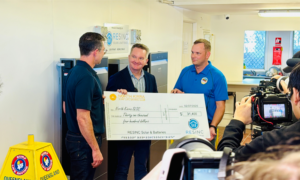In an apparent world first, Australian researchers have demonstrated a previously theoretical process – that solar power can be generated at night.
While the concept of capturing the sun’s energy at night may seem contradictory, a team from the University of New South Wales (UNSW) was able to do just that by harnessing the Earth’s own infrared thermal radiation.

Speaking to ABC RN’s Drive, Associate Professor Ned Ekins-Daukes, who led the research, explained how this process works:
“We get energy from the sun — it arrives, it warms up the Earth but then the Earth actually radiates the exact same amount of energy back out into space,” Professor Ekins-Daukes says.
By using a semiconductor device called a thermoradiative diode composed of materials found in night-vision goggles, the team was able to capture photons leaving Earth along the infrared spectrum and convert them into electricity.
While the methodology used differs considerably from photovoltaics (solar PV) which converts sunlight into electricity, Professor Ekins-Daukes says the process is ultimately still harnessing solar power.
According to him and his team, if a power cell device can be used to capture the radiant heat flow and convert into electricity, there’s “a large and unused spectrum of potential power to be exploited.”

Technology “very early stages” but has huge potential
While this technology is still in its early stages, the implications are significant. The team says proving the theoretical process is the first step in making specialised, and much more efficient, devices that could one day capture the energy at much larger scale – perhaps replacing or working alongside battery storage.
“We’ve just demonstrated that this is possible … Right now, the device we’ve made is relatively low power. [But] this is to be expected when you’re at the very early stages,” Professor Ekins-Daukes says.
The amount of energy produced was only extremely small — roughly equivalent to 1/100,000th of a solar powered cell.
“It will take some time … And I have to be honest, we need to find some new materials to achieve [widespread use].”
But he says, in the future it may be possible to combine photovoltaic devices and the thermoradiative diode for “night-time solar” power.
“You could have a panel that generates power during the day, but then could also power the other items that are still running in your house at night.”

Professor Ekins-Daukes likens the new research to the work of engineers at Bell Labs who demonstrated the first practical silicon solar cell in 1954. From only 2 per cent efficiency, research and innovation led to today’s industry-standard silicon cell with an efficiency of around 23 per cent.
And Dr Michael Nielsen, co-author of the paper, said: “Even if the commercialisation of these technologies is still a way down the road, being at the very beginning of an evolving idea is such an exciting place to be as a researcher.
“By leveraging our knowledge of how to design and optimise solar cells and borrowing materials from the existing mid-infrared photodetector community, we hope for rapid progress towards delivering the dream of solar power at night.”
Stanford University Researchers
The team at UNSW are not the only researchers exploring solutions to capture solar power at night. In the United States, scientists at Stanford University have also been working on thermal radiation-based solar cells.
The team, led by Professor Shanhui Fan modified an off-the-shelf solar cell by adding a thermoelectric generator (TEG), a device that produces currents from temperature differences.
When solar panels radiate heat at night, a phenomenon occurs that results in the panels being cooler than the night air. Using the thermoelectric generator, the team was able to exploit this temperature difference to produce electricity.
“The solar panel turned out to be a very efficient thermal radiator,” says Professor Fan. “So, at night, the solar panel can actually reach a temperature that’s below the ambient air temperature, and that’s a rather unusual opportunity for power harvesting.”
The modified solar cell generated a power output of 50 microwatts per square meter when directed towards a clear night sky. This is just 0.04 per cent of the daytime energy production of a standard solar cell. However 50 milliwatts per square meter, could enable low-power devices, such as a phone charger or a low-wattage LED light, to function.
The researchers claim that the current prototype could be improved to generate more power and there are no major barriers in one day scaling the system up to a commercial product.











































